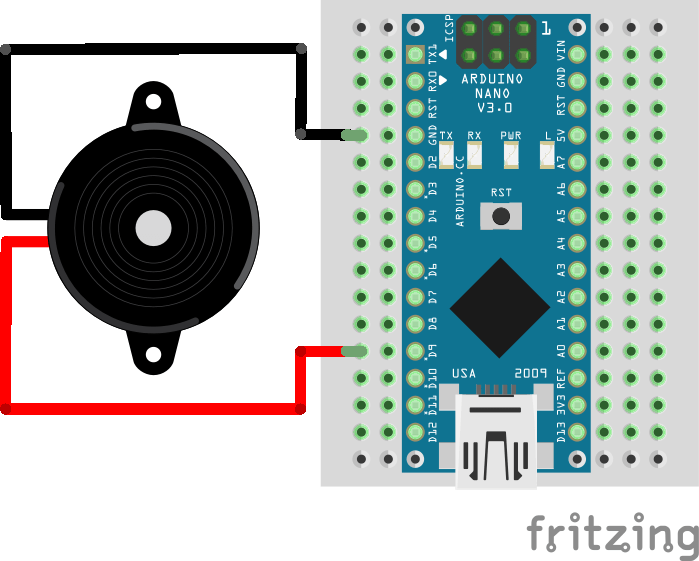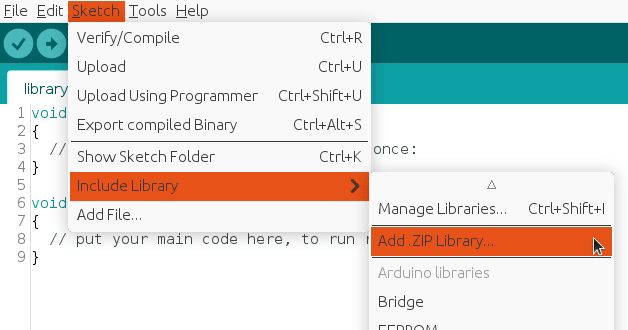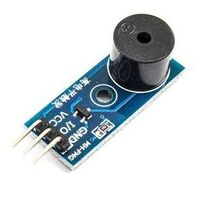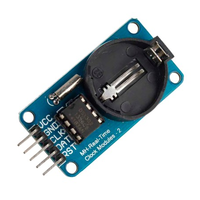Playing popular songs with Arduino and a buzzer
Buzzer is used to generate sound, beep or even melody of a song. It can be found in alarm devices, computers, timers and confirmation of user input such as a mouse click or keystroke. A piezo buzzer is not like a regular speaker that you might think of. It uses a material that actually changes shape when you apply electricity to it which in turn creates noise. The faster you bend the material, the higher the pitch of the noise that is produced.
Prerequisites
To understand the inner workings of the buzzer, we suggest checking out our article on How to use a buzzer with Arduino.
Components
| 1x Arduino Nano (or another Arduino module)
|
| 1x Mini-breadboard
|
| 1x Buzzer
|
| Dupont wires
|
| Pitches library and melodies |
Wiring schema
Pairing an Arduino and a piezo buzzer is easy. The buzzer is equipped with two pins: one for signal control and another for ground. In the setup below, the tone control will be managed by Arduino's D9 pin.

Importing pitches library
The code used to generate the melody uses an extra library available on our GitHub. This file contains all the pitch values for typical notes.
To import a library, open the Arduino IDE, go to Sketch > Include Library > Add .ZIP Library and select the library file downloaded from our GitHub repository.

Then you can simply use include statement:
#include "pitches.h"
It will include the library with predefined pitch constants so the melody generation becomes easier.
Arduino code
The main program uses two arrays, melody and durations, to define the sequence of notes and their corresponding duration, respectively. The loop() function will iterate over notes and and use assigned duration for each note. A pause between notes is introduced to distinguish them, calculated as the note's duration plus 30%. After playing a note, the noTone() function stops the buzzer to prevent any lingering sound.
#include "pitches.h"
#define BUZZER_PIN 9
int melody[] = {
// Notes goes here
};
int durations[] = {
// Notes duration goes here
};
void setup()
{
pinMode(BUZZER_PIN, OUTPUT);
}
void loop()
{
int size = sizeof(durations) / sizeof(int);
for (int note = 0; note < size; note++) {
//to calculate the note duration, take one second divided by the note type.
//e.g. quarter note = 1000 / 4, eighth note = 1000/8, etc.
int duration = 1000 / durations[note];
tone(BUZZER_PIN, melody[note], duration);
//to distinguish the notes, set a minimum time between them.
//the note's duration + 30% seems to work well:
int pauseBetweenNotes = duration * 1.30;
delay(pauseBetweenNotes);
//stop the tone playing:
noTone(BUZZER_PIN);
}
}
Note: tone() function uses one of the built in timers on the Arduino’s micro-contoller and works independently of the delay() function. Use of the tone() will interfere with PWM output on pins 3 and 11 (on boards other than the Mega).
This program provides a flexible framework for creating simple melodies by adjusting the contents of the melody and durations arrays. Users can customize the musical composition by populating these arrays with different note frequencies and durations.
Popular songs
At the moment, the following melodies are available. The list can be updated with new ones based on user requests. So, feel free to leave a comment with melodies you would like to hear.
Songs
It's a small world - contributed by @Wizmann
Movies
Games
Other
Credits
Official GitHub: https://github.com/hibit-dev/buzzer









48 Comments
HiBit Reply
The Simpsons theme has been added!
Raystorm7 Reply
Hi! it's possible to add this is halloween from the film nightmare before christmans?
I have found this link to get the note...but I can't read them :(
Piano Letter Notes
Thank you!
HiBit Reply
The Nightmare Before Christmas has been added.
Enjoy!
Chevelle1541 Reply
Motorhead's song Liar and Be My Baby. Chevelle's The Red.
HiBit Reply
Chevelle's - The Red has been added. Make sure to update pitches library as we introduced new constants.
Enjoy!
ApexNick Reply
Where is REST defined? These are failing for us.
Thanks
HiBit Reply
Hi ApexNick,
It's one of the constants defined in the pitches library:
You should download and import the library to be able to use these constants. Please check the Pitches library section of the post.
jklopcak Reply
I congratulate, what necessary words..., an excellent idea